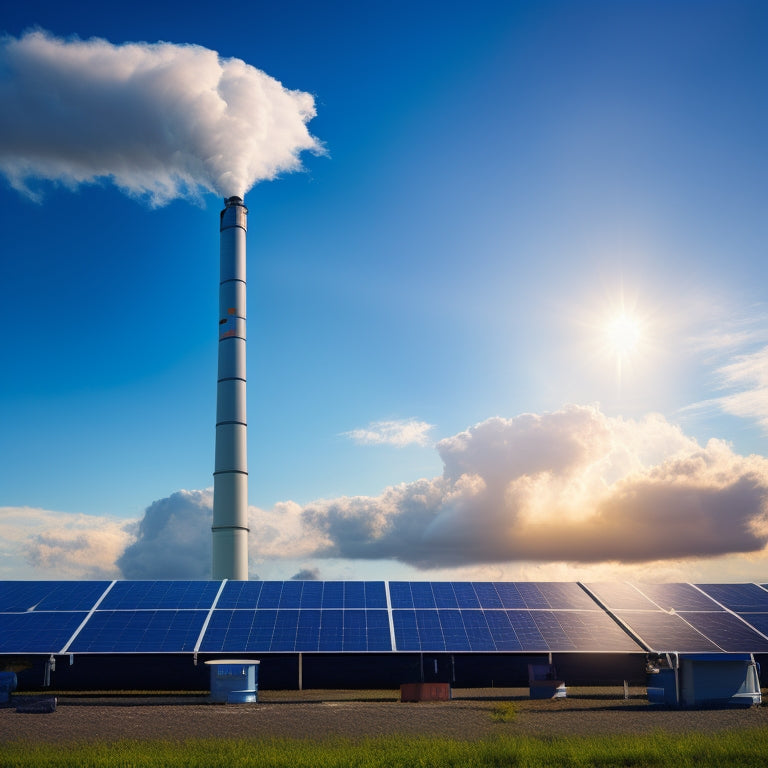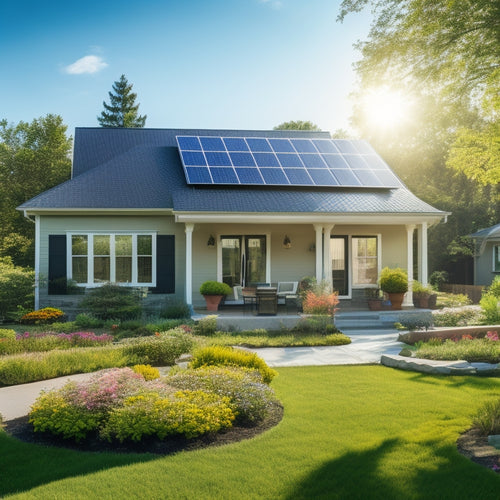
How Do Solar Panels Compare to Traditional Energy
Share
As you investigate the merits of solar panels versus traditional energy, you'll uncover a trifecta of advantages: cost savings, environmental benefits, and energy independence. Solar panels offer a competitive edge, thanks to decreasing upfront costs, government incentives, and long-term savings from generating clean energy. They also boast a lower carbon footprint and minimal ecosystem effects compared to fossil fuels. Furthermore, solar panels provide reliable energy production, with advanced inverters and smart grid technologies ensuring a steady supply. As you continue to assess the benefits, you'll reveal even more intriguing reasons to regard solar panels a viable alternative to traditional energy sources.
Key Takeaways
- Solar panels offer significant long-term savings potential and increased property resale value, offsetting upfront installation costs.
- Government incentives, such as federal tax credits and state rebates, enhance the cost-effectiveness of solar energy over traditional sources.
- Solar panels have a low carbon footprint and minimal ecosystem effects, making them a more environmentally friendly option compared to fossil fuels.
- Advanced technology and hybrid approaches enable reliable energy production and supply, even during low sunlight periods, matching traditional energy sources.
- Solar panels require minimal maintenance and have a long lifespan, typically guaranteed for 25 years or more, reducing upkeep costs and increasing overall efficiency.
Cost Comparison Over Time
Since the dawn of the renewable energy era, one of the most pressing concerns for homeowners and businesses alike has been the cost comparison between solar panels and traditional energy sources over time.
You're likely wondering whether investing in solar panels is worth the upfront installation costs. The good news is that financing options are available to help offset these costs.
Over time, you can expect significant savings potential from generating your own clean energy. Additionally, installing solar panels can increase your property's resale value.
When connecting to the grid, you can sell excess energy back to the utility company, further reducing your costs. As technology advancements continue, the cost of solar panels decreases, making them more competitive with traditional energy sources.
Regional pricing and market trends also play a role in the cost comparison. By considering these factors, you can make an informed decision about whether solar panels are a cost-effective option for you.
Environmental Impact Assessment
As you weigh the financial benefits of solar panels against traditional energy sources, you're likely also considering the environmental implications of your choice. The environmental impact assessment of solar panels versus traditional energy sources is a critical aspect of your decision.
| Energy Source | Environmental Impact | Sustainability |
|---|---|---|
| Solar Panels | Low carbon footprint, minimal ecosystem effects | High (renewable resource, pollution reduction) |
| Fossil Fuels | High carbon footprint, notable ecosystem effects | Low (resource depletion, climate change) |
| Nuclear Energy | Low carbon footprint, notable land use | Medium (energy equity, wildlife impact) |
| Hydroelectric Power | Low carbon footprint, notable ecosystem effects | High (renewable resource, sustainability practices) |
| Coal | High carbon footprint, notable ecosystem effects | Low (resource depletion, climate change) |
Solar panels have a notable lower environmental impact compared to traditional energy sources. They produce no emissions, don't contribute to resource depletion, and promote sustainability practices. In contrast, traditional energy sources like fossil fuels and coal have a high carbon footprint, contribute to ecosystem effects, and accelerate climate change. As you make your decision, consider the long-term environmental implications of your choice and the importance of promoting energy equity and pollution reduction.
Energy Production Capacity
Concerning energy production capacity, you're likely wondering whether solar panels can meet your energy demands. The answer lies in understanding solar efficiency, which is the rate at which solar panels convert sunlight into electrical energy.
Currently, commercial solar panels boast an average efficiency rate of around 20%, with top-performing models reaching up to 23%. This means that for every unit of sunlight that hits the panel, it produces 0.2-0.23 units of electricity.
In terms of grid integration, solar panels can seamlessly connect to the traditional grid, allowing you to tap into the energy supply when needed. This hybrid approach guarantees a reliable and consistent energy supply, even during periods of low sunlight.
Additionally, advanced inverters and smart grid technologies enable real-time monitoring and optimization of energy production, further enhancing the overall efficiency of the system. By combining high-efficiency solar panels with advanced grid integration, you can be confident that your energy demands will be met, while also reducing your reliance on traditional energy sources.
Maintenance and Repair Needs
You'll need to schedule regular check-ups for your solar panels to guarantee they're operating at peak levels, as dust, debris, and environmental factors can reduce their efficiency.
Over time, you may also need to replace certain components, such as inverters or panels, which can be costly and time-consuming.
Regular Check-Ups Required
About 5% of solar panels require repair or replacement within the first year of installation, and this percentage increases over time, making regular check-ups vital to maintaining ideal energy production.
As a solar panel owner, you'll want to verify your system is running at peak performance to maximize your return on investment. Regular check-ups can help identify potential issues before they escalate into costly problems.
Here are three key benefits of regular check-ups:
-
Optimized Performance: Regular maintenance guarantees your solar panels are operating at their maximum capacity, providing you with the most energy possible.
-
Extended System Lifespan: Catching minor issues early on can prevent more severe problems from developing, extending the lifespan of your solar panel system.
-
Proactive System Upgrades: Performance monitoring during check-ups can identify areas for improvement, allowing you to plan for future system upgrades that enhance energy output.
Replacement Parts Needed
Solar panel systems comprise various components that can deteriorate over time, necessitating replacement to maintain peak energy production. You'll need to replace components like inverters, mounting structures, and electrical connections to guarantee your system operates efficiently.
The durability of replacement components is vital, as it directly impacts the overall performance of your solar panel system. Look for components with a proven track record of reliability and durability to minimize the need for frequent replacements.
Sourcing replacement parts can be challenging, especially if your system is no longer under warranty. You may need to search for compatible components from the original manufacturer or alternative suppliers. This can be time-consuming and may lead to delays in getting your system back online.
To mitigate these challenges, it's important to maintain accurate records of your system's components and their specifications. This will help you quickly identify suitable replacement parts and get your system up and running again with minimal downtime.
Government Incentives and Policies
The policy environment surrounding renewable energy has undergone a significant change in recent years, with governments worldwide introducing incentives and policies to accelerate the adoption of solar panels.
As you consider shifting to solar energy, you'll want to utilize the various government incentives and policies that can help offset the upfront costs.
Here are 3 key benefits you can capitalize on:
-
Federal Tax Credits: You can claim a tax credit of up to 26% of the total cost of your solar panel system.
-
State Rebates and Renewable Energy Standards: Many states offer rebates and have set renewable energy standards, which can provide additional incentives for going solar.
-
Net Metering Policies and Utility Incentives: You can sell excess energy back to the grid and receive credits on your utility bill, or even get paid for it.
These incentives, combined with solar financing options and green energy initiatives, make solar energy a more accessible and cost-effective option.
Additionally, environmental regulations are becoming more stringent, making traditional energy sources less appealing.
Energy Independence Benefits
By leveraging government incentives and policies, you're not only reducing your upfront costs but also taking a significant step towards energy independence. This means you'll be less reliant on the grid and its fluctuating prices, ensuring a higher level of energy security.
With solar panels, you'll be generating your own clean energy, reducing your dependence on traditional fossil fuels and the grid's vulnerabilities. This, in turn, contributes to grid resilience, as decentralized energy production helps to distribute the load and reduce the strain on the grid.
As you produce your own energy, you'll be shielded from price volatility and supply chain disruptions. You'll have more control over your energy usage and costs, making it easier to budget and plan for the future.
Furthermore, energy independence enables you to make more informed decisions about your energy consumption, allowing you to optimize your energy usage and reduce waste. By investing in solar panels, you're not only saving money but also taking a vital step towards a more sustainable and self-sufficient energy future.
Space and Aesthetics Concerns
You'll need to contemplate the roof space required for solar panels, as the size and layout of your installation will impact the amount of energy you can generate.
The visual appeal of your home also matters, since solar panels can alter its exterior appearance.
As you weigh the benefits of solar energy, you'll need to balance these spatial and aesthetic concerns with your energy goals.
Roof Space Requirements
Set up your solar panel system and you'll find it's not just about utilizing renewable energy - it's also about navigating through the practicalities of roof space requirements.
As you assess your roof's suitability for solar panels, consider the following vital factors:
1. Roof Orientation: The direction your roof faces greatly influences energy production. A south-facing roof receives the most sunlight, while east- and west-facing roofs receive about 75% of the sun's energy. North-facing roofs are the least ideal.
2. Shading Effects: Shading from trees, chimneys, or neighboring buildings can reduce energy output. Even partial shading can lead to considerable losses, so it's important to assess potential obstructions.
3. Available Space: Calculate the usable roof area, considering obstructions like vents, skylights, and dormers. Confirm you have sufficient space to accommodate the required number of panels for your energy needs.
Visual Appeal Matters
While evaluating your roof's suitability for solar panels, it's not just about functionality - it's also about aesthetics. You want your solar panels to blend in with your home's design, not stick out like a sore thumb.
As you consider installing solar panels, think about how they'll impact your home's curb appeal. Will they complement your roof's color and style, or clash with them?
Fortunately, modern solar panels are designed with aesthetic integration in mind. Manufacturers offer a range of panel styles, colors, and frame options to fit various design trends.
For example, sleek and slim panels can be mounted flush to your roof, creating a streamlined look. Alternatively, you can choose panels with frames that match your roof's color, making them nearly invisible.
When selecting solar panels, look for options that align with your home's structural style and design trends. Consider factors like panel thickness, frame material, and color to guarantee a seamless aesthetic integration.
Energy Storage and Backup
How do you guarantee a steady flow of electricity when the sun isn't shining? That's where energy storage and backup come in.
With solar panels, you can't control when the sun shines, but you can control how you store and use the energy it produces.
Top Concerns for Energy Storage and Backup:
-
Battery Technology: Advanced battery systems allow you to store excess energy generated during the day for use at night or during power outages.
-
Grid Integration: Seamless integration with the grid assures a reliable supply of electricity, even when the sun isn't shining.
-
Backup Power: A reliable backup system provides peace of mind, knowing you'll have power even during extended grid outages.
Long-Term Reliability Factors
You've invested in solar panels, but you're wondering if they'll hold up over time. Performance longevity is a critical factor in determining the reliability of your solar panel system. Manufacturers typically guarantee their products for 25 years or more, but what happens after that?
| Reliability Factor | Solar Panels | Traditional Energy |
|---|---|---|
| Weather Resilience | Designed to withstand extreme weather conditions, including hail, high winds, and heavy snowfall | Susceptible to weather-related outages and disruptions |
| Performance Longevity | Guaranteed to maintain at least 80% of initial performance after 25 years | Can degrade over time, reducing energy output |
| Maintenance Requirements | Minimal maintenance required, with occasional cleaning and inspection | Regular maintenance and repairs necessary to guarantee peak performance |
Solar panels are designed to provide reliable energy output over an extended period. They're built to withstand harsh weather conditions, and their performance remains consistent even after 25 years. In contrast, traditional energy sources can be affected by weather-related outages and require more frequent maintenance. With solar panels, you can enjoy a reliable and consistent source of energy for years to come.
Frequently Asked Questions
Can Solar Panels Generate Electricity During Power Outages?
You can generate electricity during power outages with solar panels if you're connected to an off-grid system with battery storage, allowing you to store excess energy generated during the day for use at night or during outages.
Do Solar Panels Work Well in Cloudy or Shaded Areas?
You wonder if solar panels can still capture power on gloomy days; the answer lies in solar efficiency. While shading impact reduces output, modern panels can still generate electricity, albeit at a lower capacity, even in cloudy or partially shaded areas.
Are Solar Panels Resistant to Extreme Weather Conditions?
You'll find solar panels are designed to withstand extreme weather conditions, boasting impressive durability and resilience; they can tolerate heavy rain, hail, and even hurricane-force winds, ensuring your power supply remains stable and uninterrupted.
Can I Install Solar Panels on My Old or Historic Home?
As you envision utilizing sunlight on your historic home's rooftop, consider aesthetic considerations: will sleek panels blend with ornate design? Installation challenges arise with older structures, but careful planning and expert execution can guarantee a seamless, energy-efficient upgrade that respects your home's heritage.
Will Solar Panels Increase My Property's Resale Value?
You'll likely see an increase in your property's resale worth with solar panels, as they're viewed as a worthwhile investment, enhancing your property appraisal by up to 17%, according to the National Renewable Energy Laboratory.
Conclusion
As you weigh the pros and cons of solar panels against traditional energy, consider this: switching to solar is like trading in a gas-guzzler for a fuel-efficient vehicle. Initially, the sticker shock might be intimidating, but over time, you'll reap the benefits of lower "fuel" costs and reduced environmental guilt. In fact, the average American homeowner saves around $500 annually on electricity bills by going solar. Make the smart investment today, and you'll be cruising towards energy independence in no time.
Related Posts
-

Energy-Efficient Lighting Solutions for Sustainable Buildings
For sustainable buildings, energy-efficient lighting solutions, like LEDs, offer multiple benefits. These bulbs last ...
-

Energy-Efficient Home Upgrades for Cost Reduction
To reduce costs with energy-efficient home upgrades, focus on essential improvements like smart thermostats, energy-e...
-

Affordable Solar Panels for Home Use
Affordable solar panels offer you a smart way to cut down on energy costs while promoting sustainability. With govern...


